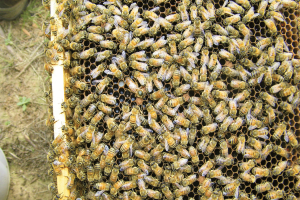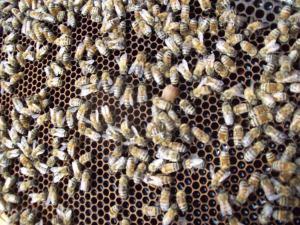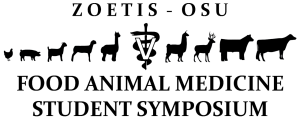By: Clarence Collison
Recognition
Within the honey bee colony, recognition of nestmates from aliens is based on olfactory cues.
Recognition of colony members is extremely important in maintaining the integrity of the honey bee family. To discriminate between nest mates and non-nest mates, guard honey bees antennate and lick workers encountered at the nest entrance (Butler and Free 1952), thereby assessing the entering bee’s odor recognition cues. The cues used to discriminate between nest mates and non-nest mates are suggested to originate from various sources: queen (Moritz and Crewe 1988; Saleh-Mghir and Darchen 1990; Breed et al. 1992), stored food (Ribbands et al. 1952), and comb wax (Breed et al. 1988, 1995).
Within the honey bee colony, recognition of nestmates from aliens is based on olfactory cues, and several studies have demonstrated that such cues are contained within the lipid layer covering the cuticle. Such cues may be both self-produced and exogenous (Breed et al. 1998). Self-produced cues may have both a genetic and an environmental component, for example depending on the type of food, while exogenous cues may also have a genetic component (as, for example, the odors acquired from other nestmates or from the nest material produced by nestmates) as well as an environmental one. Heritable self-produced cues appear to be of little importance in nestmate recognition, at least in a natural context, and guard bees appear to be unable to discriminate between related and unrelated conspecifics if these have lived within their hive during adulthood (Downs and Ratnieks 1999). Among the environmental components, nest material (Breed et al. 1998) rather than food source (Downs et al. 2001) and odors acquired from flowers (Bowden et al. 1998; Downs et al. 2000), appear to be the most important source of recognition cues.
The lipids covering the body surface are usually a complex mixture of tens of compounds in which aliphatic hydrocarbons are generally the major components. Dani et al. (2005) tested whether artificial changes in the cuticular profile through supplementation of naturally occurring alkanes and alkenes in honey bees affect the behavior of nestmate guards. Compounds were applied to live foragers in microgram quantities and the bees returned to their hive entrance where the behavior of the guard bees was observed. In this fashion they compared the effect of single alkenes with that of single alkanes; the effect of mixtures of alkenes versus that of mixtures of alkanes and the whole alkane fraction separated from the cuticular lipids versus the alkene fraction. With only one exception (the comparison between n-C19 and (Z)9-C19), in all the experiments bees treated with alkenes were attacked more intensively than bees treated with alkanes. They concluded that modification of the natural chemical profile with the two different classes of compounds has a different effect on acceptance and suggests that this may correspond to a differential importance in the recognition signature.
“Wax comb in honey bee colonies serves as a source and
medium for transmission of recognition cues.”
Worker honey bees are able to discriminate between combs on the basis of genetic similarity to a learned comb. The nestmate recognition cues that they acquire from the comb also have a genetically correlated component. Cues are acquired from comb in very short exposure periods (five minutes or less) and can be transferred among bees that are in physical contact. Gas chromatographic analysis demonstrates that bees with exposure to comb have different chemical surface profiles than bees without such exposure. These results support the hypothesis that comb-derived recognition cues are highly important in honey bee nestmate recognition. These cues are at least in part derived from the wax itself, rather than from floral scents that have been absorbed by the wax (Breed et al. 1995).
Breed et al. (1988) showed that worker honey bees kept in paper cartons on comb wax will accept workers who have been exposed to the same comb as themselves but reject workers exposed to a different comb. Worker relatedness had no significant effect on acceptance. Chemical analyses have shown that workers acquire new chemicals when exposed to comb (Breed et al. 1995), supporting the conclusion that environmental cues are used during recognition. Breed (1987) also showed that a test group of workers kept in a paper carton will reject sisters kept in a hive for one to five days and then introduced into the carton, presumably because they acquired new cues while in the hive.
Wax comb in honey bee colonies serves as a source and medium for transmission of recognition cues. Workers learn the identity of their primary nesting material, the wax comb, within an hour of emergence (Breed and Stiller 1992). Research has shown that the wax combs are important in the acquisition of colony odor. However, many of these studies were conducted in the laboratory or under artificial conditions. D’ettorre et al. (2006) investigated the role of the wax combs in nestmate recognition in the natural context of bees at colony entrances. Wax combs constructed by each experimental colony were swapped between hives and the acceptance of nestmate and non-nestmate forager workers was recorded before and after the swap, and in relation to a control hive not involved in the swap. A standard assay of guard discrimination (Downs and Ratnieks 2000) was used. Returning forager workers without pollen were captured at the entrance of their own colony (the source colony), individually placed in plastic vials and cooled in a portable ice chest. The chilled bees were then allowed to warm up before being released individually at the entrance of a discriminator colony. The chilling made the bees reluctant to fly away even though they were fully active on release. They observed the reaction of guards for five minutes. An introduced worker that was bitten, stung or dragged by guard bees was classed as rejected. Workers that were only antennuated or licked by guards or that remained at the entrance for five minutes without receiving aggression were classed as accepted. Introductions were made by a pair of researchers, one of whom acted as the observer and was blind with respect to the colony of origin of the introduced bee. To introduce bees, they collected three returning foragers from one source hive. One was introduced back to its own hive (nestmates) and one each into the other two hives (non-nestmates). The procedure was repeated with foragers from the other two hives to constitute one round of nine introductions. Colonies that exchanged combs became more accepting of each other’s workers than of workers from the third colony. The overall acceptance of comb swap non-nestmates increased significantly from 3% before the swap to 23% after the swap in the first year, and from eight to 47% in the second year. This effect wore off within three weeks. Chemical analyses showed that the cuticular profile of non-nestmates involved in the experimental comb swap became more similar to each other after the swap, and that acceptance by guards of bees from different hives was negatively correlated with chemical distance between the hydrocarbon profiles of the workers from different hives (D’ettorre et al. 2006).
Honey bee colonies rob honey from each other during periods of nectar shortage. Persistent robbing can kill weak colonies. Primarily responsible for preventing robbing are guard bees. Previous research has shown that the probability of both nest mate and non-nestmate workers being accepted by guards at the nest entrance increases as nectar availability increases. The mechanism responsible for this change in guard acceptance may be explained by two competing hypotheses: Odor Convergence and Adaptive Threshold Shift. Similarity in colony odors caused by foraging on the same plant species is referred to as Odor Convergence (Downs and Ratnieks 1999). Downs et al. (2001) tested the Odor Convergence hypothesis. The acceptance by guards at the nest entrance of workers transferred between four colonies that had been fed either odorless sucrose syrup (two colonies) or diluted heather honey (Calluna vulgaris) (two colonies) was measured three days before feeding and during two weeks of feeding. Despite the large sample sizes, the probability of guards accepting non-nest mates was not affected by the similarities or dissimilarities in food odor between guards’ and non-nest mate’ colonies. This finding contrasts with the accepted belief that food odors are important in nest mate recognition and strongly rejects the Odor Convergence hypothesis
.
“The olfactory cues which workers use when discriminating between queens may be odors that the queens have acquired from the hive environment, or may be pheromones that the queens have produced themselves.”
The Adaptive Threshold Shift hypothesis predicts that as the costs and frequency of robbing declines, the acceptance threshold of guard bees becomes more permissive. Downs and Ratnieks (2000) provide data strongly supporting this hypothesis. Over several weeks guards became more accepting of both nest mates and non-nest mates as foraging conditions changed from nectar dearth to abundance. Eventually, all bees, both nest mates and non-nest mates were accepted.
Worker honey bees recognize their own queen and can distinguish her from others on the basis of odors. Boch and Morse (1982) demonstrated this experimentally by giving a swarm of bees the choice between its own queen and a queen from another colony; swarms moved to their own queen in most trials (Boch and Morse 1974, 1979, 1981). The olfactory cues which workers use when discriminating between queens may be odors that the queens have acquired from the hive environment, or may be pheromones that the queens have produced themselves (Breed 1981). Queen pheromones vary among individuals in both quantity and composition and may convey information on the physiological state of the queen, reflecting differences in diet, rearing history, age, mating etc. (Ambrose et al. 1979). The recognition odor cues of queens are in part genetically determined and in part acquired from the hive environment (Boch and Morse 1982).
A honey bee queen is usually attacked if she is placed among the workers of a colony other than her own. This rejection occurs even if environmental sources of odor, such as food, water, and genetic origin of the workers, are kept constant in laboratory conditions (Breed 1981). The genetic similarity of queens determines how similar their recognition characteristics are; inbred sister queens were accepted in 35% of exchanges, outbred sister queens in 12%, and non-sister queens in 0%. Carbon dioxide narcosis results in worker honey bees accepting non-nest mate queens. A learning curve was developed over a 30 minute to five hour period, indicating the time after narcosis required by workers to learn to recognize a new queen. In contrast to queens, worker transfers normally result in only a small percentage of the workers being rejected. The reason for this difference between queens and workers may be because their recognition cues come from different sources.

Worker honey bees recognize their own queen, from odors from the hive, or pheromones from the queen.
The intolerance and the aggressive behavior of workers toward alien individuals of the hive are widely known. But in some circumstances, workers of different hives can live together without fighting. Saleh-Mghir and Darchen (1990) looked for factors which stop this aggressive behavior toward alien individuals. Basic to our understanding of these aggressive behaviors is the effect of colony odors which have various origins, including the hive materials and metabolic products of the workers or the queen. They investigated the effects of the queen’s metabolism on nest mate recognition.
Experiments were made with populations of 75 workers of various ages taken from the same hive and kept in cages. Seventy-two hours elapsed between the time when the workers were put in cages and the first observation. Five workers were introduced from cage X into cage Y and vice versa, and the aggressiveness of the receiver workers towards one worker chosen amongst the five workers introduced was classified from one (no aggressiveness) to five (struggle and killing of the intruder). Every set of observations lasted 10 minutes and was repeated daily for seven days. They demonstrated that the queen’s odor played an important part in the colony odor. They found that: 1) queenless sister workers readily recognize one another, even a long time after their separation, 2) workers living with a queen easily accept their queenless sisters, and 3) queenless workers reject their sisters that have lived with a queen for 72 hours. The first two results may be explained by aspects of kin recognition but not the last one. They hypothesized that queenless workers slowly lose their queen’s odor, while workers with queens are continuously marked by the queen pheromone (Saleh-Mghir and Darchen 1990).
Fatty acids, normally found in comb wax, have a strong influence on nestmate recognition. Previous work has shown that bees from different colonies, when treated with 16- or 18-carbon fatty acids, such as oleic, linoleic, or linolenic acids, are much less likely to fight than bees from two colonies when only one of the two is treated. Previous work also shows that the influence of comb wax on recognition has practical applications; transfer of empty comb between colonies, before merger of those colonies, reduces fighting among workers within the merged colony. Flax oil contains many of the same fatty acids as beeswax. Breed et al. (2012) tested the hypothesis that treatment of individual bees with flax oil affects nestmate recognition; the results proved to be consistent with this hypothesis and showed that treated bees from different colonies were less likely to fight than untreated bees. These results suggest that flax oil may be useful in facilitating colony mergers.
References
Ambrose, J.T., R.A. Morse and R. Boch 1979. Queen discrimination by honey bee swarms. Ann. Entomol. Soc. Am. 72: 673-675.
Boch, R. and R.A. Morse 1974. Discrimination of familiar and foreign queens by honey bee swarms. Ann. Entomol. Soc. Am. 67: 709-711.
Boch, R. and R.A. Morse 1979. Individual recognition of queens by honey bee swarms. Ann. Entomol. Soc. Am. 72: 51-53.
Boch, R. and R.A. Morse 1981. Effects of artificial odors and pheromones on queen discrimination by honey bees. Ann. Entomol. Soc. Am. 74: 66-67.
Boch, R. and R.A. Morse 1982. Genetic factor in queen recognition odors of honey bees. Ann. Entomol. Soc. Am. 75: 654-656.
Bowden, R.M., S. Williamson and M.D. Breed 1998. Floral oils: their effect on nestmate recognition in the honey bee, Apis mellifera. Insect. Soc. 45: 209-214.
Breed, M.D. 1981. Individual recognition and learning of queen odors by worker honeybees. Proc. Natl. Acad. Sci., USA 78: 2635-2637.
Breed, M.D. 1987. Multiple inputs in the nestmate discrimination system of the honey bee. In: Chemistry and Biology of Social Insects (Ed. By J.Eder and H. Rembold), pp. 461-462. Munich: Verlag.
Breed, M.D. and T.M. Stiller 1992. Honey bee, Apis mellifera, nestmate discrimination: hydrocarbon effects and the evolutionary implications of comb choice. Anim. Behav. 43: 815-883.
Breed, M.D., K.R. Williams and J.H. Fewell 1988. Comb wax mediates the acquisition of nest-mate recognition cues in honey bees. Proc. Natl. Acad. Sci. 85: 8766-8769.
Breed, M.D., T.M. Stiller, M.S. Blum and R.E. Page, Jr. 1992. Honey bee nestmate recognition effects of queen fecal pheromones. J. Chem. Ecol. 18: 1633-1640.
Breed, M.D., M.F. Garry, A.N. Pearce, B.E. Hibbard, L.B. Bjostad and R.E. Page, Jr. 1995. The role of wax comb in honey bee nestmate recognition. Anim. Behav. 50: 489-496.
Breed, M.D., E.A. Leger, A.N. Pearce and Y.J. Wang 1998. Comb effects on the ontogeny of honey bee nestmate recognition. Anim. Behav. 55: 13-20.
Breed, M.D., C.A. Lyon, A. Sutherland and R. Buchwald 2012. Use of flax oil to influence honey bee nestmate recognition. J. Econ. Entomol. 105: 1145-1148.
Butler, G.G. and J.B. Free 1952. The behaviour of worker honeybees at the hive entrance. Behaviour 4: 263-291.
Dani, F.R., G.R. Jones, S. Corsi, R. Beard, D. Pradella and S. Turillazzi 2005. Nestmate recognition cues in the honey bee: differential importance of cuticular alkanes and alkenes. Chem. Senses. 30: 477-489.
D’ettorre, P., T. Wenseleers, J. Dawson, S. Hutchinson, T. Boswell and F.L.W. Ratnieks 2006. Wax combs mediate nestmate recognition by guard honeybees. Anim. Behav. 71: 773-779.
Downs, S.G. and F.L.W. Ratnieks 1999. Recognition of conspecifics by honeybee guards uses non-heritable cues acquired in the adult stage. Anim. Behav. 58: 643-648.
Downs, S.G. and F.L.W. Ratnieks 2000. Adaptive shifts in honey bee (Apis mellifera L.) guarding behavior support predictions of the acceptance threshold model. Behav. Ecol. 11: 326-333.
Downs, S.G., F.L.W. Ratnieks, S.L. Jefferies and H.E. Rigby 2000. The role of floral oils in the nestmate recognition system of honey bees (Apis mellifera L.). Apidologie 31: 357-365.
Downs, S.G., F.L.W. Ratnieks, N.S. Badcock and A. Mynott 2001. Honeybee guards do not use food-derived odors to recognize non-nestmates: a test of the Odor Convergence hypothesis. Behav. Ecol. 12: 47-50.
Moritz, R.F.A. and R.M. Crewe 1988. Chemical signals of queens in kin recognition in honeybees, Apis mellifera L. J. Comp. Physiol. A 164: 83-89.
Ribbands, C.R., H. Kalmus and H.L. Nixon 1952. New evidence of communication in the honeybee colony. Nature 170: 438-440.
Saleh-Mghir, E. and R. Darchen 1990. The queen part in the tolerance between worker bees, Apis mellifera mellifera. Apidologie 21: 59-67.
Clarence Collison is an Emeritus Professor of Entomology and Department Head Emeritus of Entomology and Plant Pathology at Mississippi State University, Mississippi State, MS.










